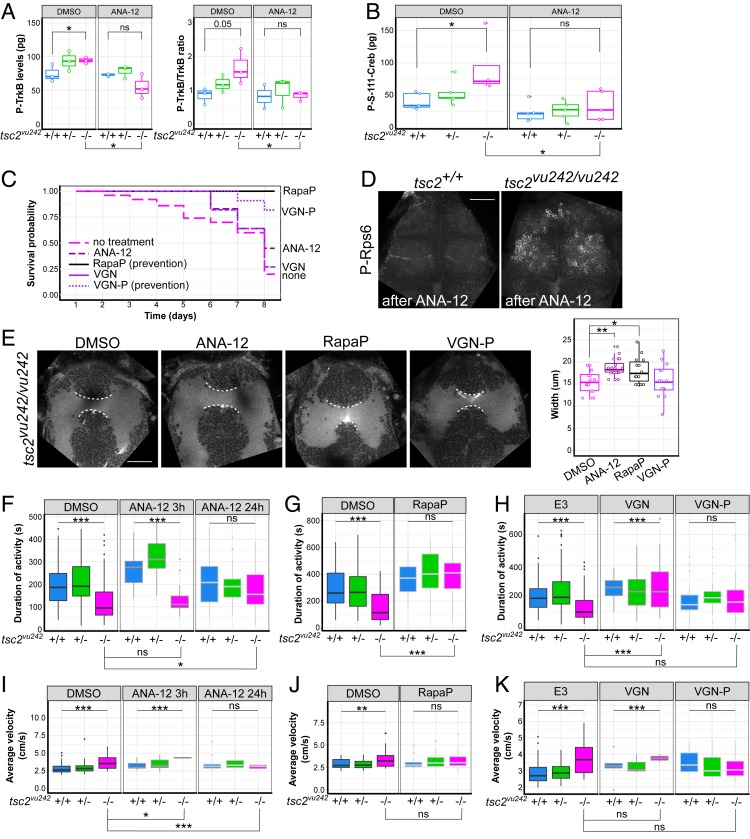Fig. 5.
ANA-12 rescues survival, brain dysconnectivity, impairment in locomotion, and anxiety-related hypervelocity in tsc2vu242vu/242 mutants. (A) Quantification of activation of TrkB receptor judged by levels of P-TrkB and ratio of P-TrkB to TrkB by immunochemistry (ELISA) revealed higher activation levels in tsc2vu242/vu242 fish compared with control siblings and a decrease after ANA-12 treatment [P-TrkB: H = 4.355, P = 0.049; P = 0.05, tsc2vu242/vu242 vs. tsc2+/+ (Dunn’s test)]; P = 0.015, tsc2vu242/vu242 untreated vs. treated with ANA-12 (Dunn’s test); P-TrkB/TrkB: H = 5.689, P = 0.05; P = 0.05, tsc2vu242/vu242 vs. tsc2+/+ (Dunn’s test); P = 0.049, tsc2vu242/vu242 untreated vs. treated with ANA-12 (Dunn’s test)]. (B) Quantification of levels of Creb phosphorylation by immunochemistry (ELISA) revealed higher levels in tsc2vu242/vu242 compared with controls and a decrease after ANA-12 treatment [genotype: F = 3.513, P = 4.66 × 10−4; treatment: F = 14.759, P = 8.33 × 10−4; genotype × treatment: P > 0.05; P = 0.012, tsc2vu242/vu242 after ANA-12 vs. DMSO treatment (Tukey HSD test); P = 0.033, untreated tsc2vu242/vu242 vs. tsc2+/+ (Tukey HSD test)]. (C) Survival probability of tsc2vu242/vu242 after various treatments. (D) Confocal images of tsc2vu242 brains that were immunostained with anti–P-Rps6 antibody after ANA-12 treatment. (Scale bar, 30 µm.) (E) AC width in tsc2vu242/vu242 after various treatments, including representative confocal images and quantification [F = 5.83, P = 0.00142; P = 0.002 for DMSO vs. ANA-12, P = 0.049 for DMSO vs. Rapa pretreatment (Dunnett’s test)]. (Scale bar, 30 µm.) (F) Cumulative activity of tsc2vu242/vu242 after treatment with ANA-12 compared with tsc2vu242/+ and tsc2+/+ fish over 1 h of tracking, showing an increase in activity of mutant fish after treatment [H = 16.652, P = 2.42 × 10−4; P = 0.0172, tsc2vu242/vu242 untreated vs. treated with ANA-12 for 24 h (Dunn’s test)]. (G) Cumulative activity of the tsc2vu242/vu242 after the prevention of disease development by Rapa pretreatment compared with tsc2vu242/+ and tsc2+/+ fish over 1 h of tracking, showing an increase in activity of mutant fish after treatment [H = 32.18, P = 3.9 × 10−8; P = 2.0 × 10−8 for tsc2vu242/vu242 untreated vs. rapamycin pretreatment (Dunn’s test)]. (H) Cumulative activity of tsc2vu242/vu242 after the treatment with VGN or VGN-P to prevent disease development, respectively, compared with tsc2vu242/+ and tsc2+/+ fish over 1 h of tracking, showing improvements in activity after short VGN treatment but toxicity after longer treatment with VGN [H = 19.262, P = 6.566 × 10−5; P = 3.4 × 10−5 for tsc2vu242/vu242 untreated vs. treated with VGN, P > 0.05 for tsc2vu242/vu242 untreated vs. VGN-P (Dunn’s test)]. (I) Average velocity of high-velocity movements of tsc2vu242/vu242 compared with tsc2vu242/+ and tsc2+/+ fish after treatment with ANA-12 [H = 14.686, P = 6.47 × 10−4; P = 0.015 for tsc2vu242/vu242 untreated vs. treated with ANA-12 for 3 h, P = 0.003 for tsc2vu242/vu242 untreated vs. treated with ANA-12 for 24 h (Dunn’s test)]. (J) Average velocity of high-velocity movements of tsc2vu242/vu242 fish after the prevention of disease development with Rapa pretreatment compared with tsc2vu242/+ and tsc2+/+ fish [H = 29.68, P = 4.52 × 10−5; P > 0.05 for tsc2vu242/vu242 untreated vs. tsc2vu242/vu242 with Rapa pretreatment (Dunn’s test)]. (K) Average velocity of high-velocity movements of tsc2vu242/vu242 after the treatment with VGN or VGN-P to prevent disease development, respectively, compared with tsc2vu242/+ and tsc2+/+ fish (H = 3.286, P = 0.19). *P < 0.05, **P < 0.01, ***P < 0.005, ns: not significant.

